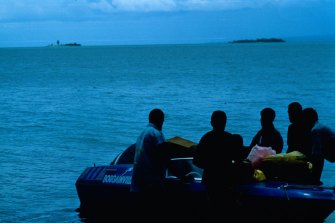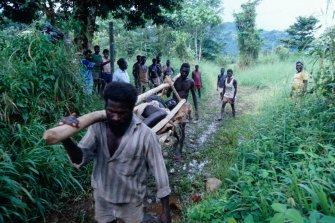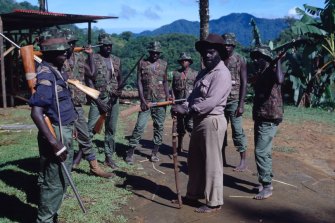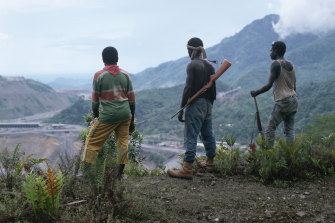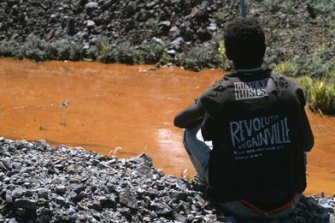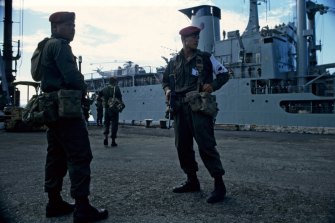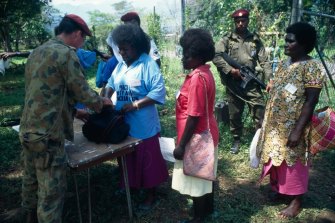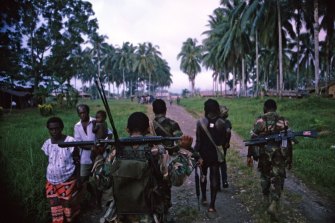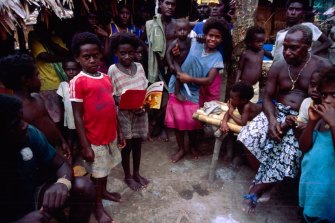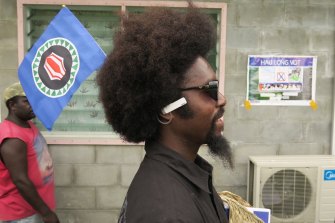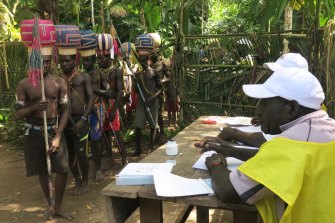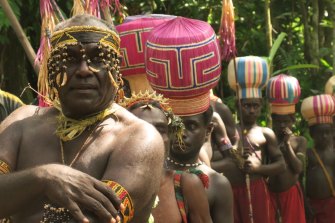Bougainville’s long struggle for nationhood achieved another milestone when its people voted 97.7 per cent in favour of independence in an internationally supervised referendum conducted in recent weeks.
The governments of Papua New Guinea and Bougainville will soon go into consultations, as stipulated by the Bougainville Peace Agreement of 2001, to arrive at a negotiated settlement that must then be ratified by the PNG parliament before Bougainville can become a new nation.
As a photojournalist based in Vanuatu, I have been reporting on Bougainville and the wider Pacific region for the past 25 years. I covered both sides of Bougainville's war and a succession of Australian-supported regional peacekeeping operations there. In 1994 I ran PNG's naval blockade and spent a month on the island with the Bougainville Revolutionary Army (BRA), securing the first interview and pictures of BRA leader Francis Ona, while seeing first hand the destruction at the Panguna mine. On later visits I patrolled with the PNG Defence Forces and their local Bougainville Resistance Force (BRF) allies.
This photo gallery draws on photos I took spanning 25 years of Bougainville's history in times of war and peace and more recently, their vote for nationhood.
“The Run”, 1994.Credit:Ben Bohane
1. Running the naval blockade of Bougainville by speedboat during the war was known as “The Run”. When I left the island following my first Run, seen here in 1994, the boat after mine was intercepted and everyone on board shot dead. Boats like these carried medicine and supplies in from the neighbouring Solomon Islands and took wounded out, a vital link to the outside world.
Carrying a wounded guerrilla.Credit:Ben Bohane
2. During my trek up to see BRA leader Francis Ona in 1994 I accompanied guerrillas from the coast up to his mountain stronghold above the war. Along the way we came under mortar fire by the PNG Defence Forces and one of the BRA fighters was hit with shrapnel. The men quickly made a bush stretcher and carried him to a nearby village for treatment.
Meeting rebel leader Francis Ona.Credit:Ben Bohane
3. BRA leader Francis Ona, barefoot, wearing his Akubra hat and holding a Japanese sword, stands with some of his men in Guava village above the Panguna mine. He told me, in words I have never forgotten: “We are at war with Australia, but it is not our intention. We wish they could be neutral.”
Separatists stand over the Panguna mine.Credit:Ben Bohane
4. From Rio Tinto Zinc’s “jewel in the crown” to an industrial wasteland taken over by landowners and BRA guerrillas, the Panguna copper and gold mine was at the heart of the conflict and may be the key to an independent future.
Pollution near the Panguna mine.Credit:Ben Bohane
5. Pollution was a major factor behind landowners and the BRA deciding to close the Panguna mine. Here a BRA guerrilla sits by the banks of a contaminated river running from the mine. A nearby tailings dam continues to leech chemicals into water systems decades after the mine closed.
Peacekeepers arrive.Credit:Ben Bohane
6. Australia provided logistics and personnel for several regional peacekeeping missions in Bougainville, beginning with the South Pacific Regional Peacekeeping Force to secure peace talks around the capital Arawa for a two-week period in late 1994. The talks failed and the island returned to war. Here, troops from Fiji, Tonga, New Zealand and other Pacific nations arrive by Australian naval ship at the Loloho wharf in Arawa to begin their mission.
Turning up for peace talks.Credit:Ben Bohane
7. Australian and Pacific island troops inspect delegates attending the peace talks in Arawa. This mission was followed in later years by the Truce Monitoring Group in 1997 and the Peace Monitoring Group deployed from 1998 to 2003. These regional peacekeeping missions set the template for later Australian interventions in the Solomon Islands and East Timor.
PNG forces patrol villages with their BRF allies.Credit:Ben Bohane
8. PNG troops patrol villages around central and southern Bougainville with their BRF allies in 1995. While most Bougainvilleans supported the BRA, there were some communities who sided with PNG due to BRA violence and intimidation. Old tribal rivalries and traditions around “payback” were also a factor in dividing some communities. A long process of ‘kastom’ reconciliation ceremonies have since united former foes.
Internally displaced Bougainvilleans became a “lost generation”.Credit:Ben Bohane
9. During the war, internally displaced refugees often moved into basic “care centres” deep in the bush to avoid fighting between groups. The centres suffered many privations but kept communities safe. One consequence, however, was the loss of education for an entire generation. This photo is of a care centre in central Bougainville in 1995.
First in, best dressed.Credit:Ben Bohane
10. A man with a Bougainville flag in his hair prepares to vote during the 2019 referendum. On November 23, the first polling stations were opened and within hours thousands were lining up to vote in a referendum many had waited decades for. This polling station was the first to open in the old capital Arawa on the day.
A break in initiation rites.Credit:Ben Bohane
11. Young men wearing Upe hats emerge from the bush at Teuapaii village, Kunua, to vote in the referendum. The Upe hat, worn by boys and young men for three years as they are sequestered in the bush and go through their initiation rites, has come to be the symbol of Bougainville and is at the centre of the Bougainville flag.
A new generation maintains pre-Christian traditions.Credit:Ben Bohane
12. John Sisiesi, the returning officer for Bougainville’s referendum, stands with boys wearing Upe hats as they emerge from the bush. Sisiesi is from a community nearby, along the north-west coast of Bougainville, one of the few areas where the Upe tradition continues after Christian missionary activity over the past 100 years curbed it elsewhere. The boys are isolated in the bush for some years learning tribal law, bush skills, fighting and house building, bush medicine and love magic. As the Upe symbolises maturity, some see it as a fitting symbol for Bougainville as it comes to maturity in nationhood.
This gallery is a part of a project developed by Ben Bohane, the Walkley Foundation and Nine newspapers.
Source: Read Full Article

